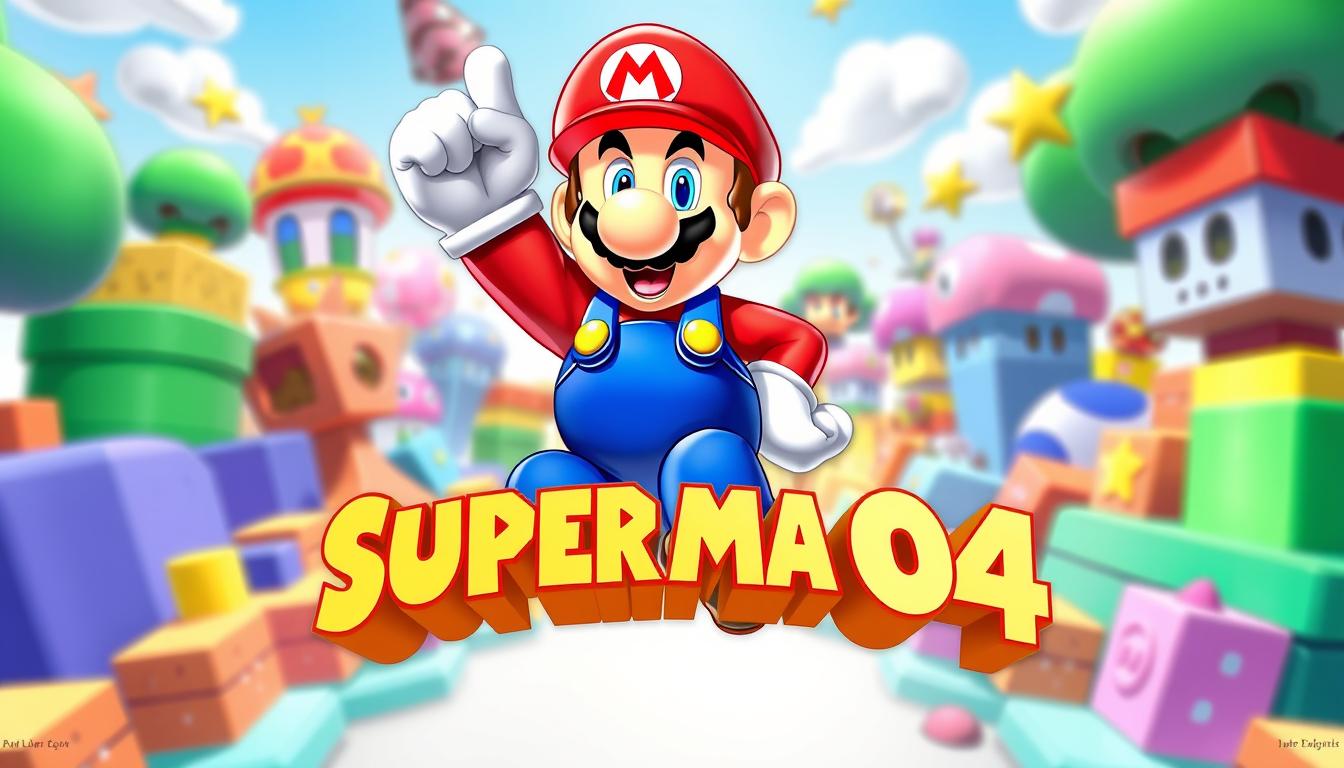The 1990s was a transformative period for the gaming industry, marked by significant technological advancements that paved the way for future innovations.
This decade witnessed the emergence of groundbreaking titles across various genres, captivating audiences worldwide and leaving a lasting impact on the industry.
The transition from 2D to 3D gaming was a hallmark of the era, with many iconic games still celebrated today for their innovative gameplay and immersive experiences.
As we look back, it’s clear that the 1990s laid the foundation for the modern gaming landscape.
Key Takeaways
- The 1990s saw significant advancements in gaming technology.
- Iconic game titles from the 90s continue to influence the industry.
- The decade was marked by a transition from 2D to 3D gaming.
- Many games from the 90s remain celebrated for their innovative gameplay.
- The legacy of 90s gaming can still be seen in modern games.
The Golden Era of Gaming: Why the 90s Changed Everything
With the advent of the 90s, the video game industry experienced a paradigm shift, driven by technological innovation and creative visionaries. This decade was a time of great change in the gaming world, with the shift from 2D to 3D graphics being a major factor.
The technical revolution of the 90s was a game-changer, enabling the development of more complex and engaging games. The transition to 3D gaming opened up new possibilities for game design and player experience. As a result, gamers were treated to immersive worlds that were previously unimaginable.
From 2D to 3D: The Technical Revolution
The shift from 2D to 3D graphics was not just a technical upgrade; it was a fundamental transformation that changed the way games were designed and played. This transition allowed for more realistic environments, enhanced gameplay mechanics, and a more engaging player experience.
One of the key innovations of this period was the introduction of 3D graphics acceleration hardware, which enabled faster rendering of 3D graphics and paved the way for more complex game worlds. As noted by Steven L. Kent, author of “The Ultimate History of Video Games,” the impact of 3D graphics on gaming was profound, allowing for “a level of immersion that was previously impossible.”
“The introduction of 3D graphics in the 1990s revolutionized the gaming industry, enabling the creation of immersive and interactive worlds that captivated players worldwide.”
| Technical Advancement | Impact on Gaming |
|---|---|
| 3D Graphics Acceleration Hardware | Faster rendering of 3D graphics, enabling more complex game worlds |
| Transition to 3D Gaming | More realistic environments, enhanced gameplay mechanics, and immersive player experience |
The Birth of Iconic Franchises
The 90s also saw the emergence of iconic franchises that remain popular today. Franchises such as Super Mario, The Legend of Zelda, and Final Fantasy were either born or significantly evolved during this decade. These franchises have continued to influence gaming, with many of their titles remaining beloved classics.
- The technical revolution of the 90s enabled the development of more complex and engaging games, setting the stage for future innovations.
- Iconic franchises born or evolved during this decade have had a lasting impact on the gaming industry.
- The transition to 3D gaming opened up new possibilities for game design and player experience, changing the gaming landscape forever.
In conclusion, the 90s were a pivotal time for the gaming industry, marked by significant technical advancements and the emergence of iconic franchises. The impact of this decade can still be felt today, with many of the innovations and franchises born during this period continuing to shape the gaming world.
Super Mario 64 (1996): Redefining 3D Platformers
With the launch of Super Mario 64, the gaming world witnessed a paradigm shift in 3D gaming. This iconic title not only revolutionized the platformer genre but also set a new benchmark for 3D gameplay.
Revolutionary 3D Controls and Camera System
Super Mario 64 was a pioneering title in 3D platforming, offering a new type of gaming experience. The game’s controls and camera system were revolutionary for its time, providing a sense of freedom and exploration that was unprecedented.
The innovative controls allowed players to navigate through the 3D world with ease, creating a more immersive experience. The camera system, although sometimes challenging, added to the sense of adventure and discovery.
Impact on Modern Gaming
The impact of Super Mario 64 can be seen in many modern 3D platformers, which have built upon its innovations. The game’s influence extends beyond the platformer genre, with its 3D gameplay mechanics being adopted by various other genres.
- Super Mario 64 was a pioneering title in 3D platforming, offering a new type of gaming experience.
- The game’s controls and camera system were revolutionary for its time, providing a sense of freedom and exploration.
- The impact of Super Mario 64 can be seen in many modern 3D platformers, which have built upon its innovations.
- The game’s influence extends beyond the platformer genre, with its 3D gameplay mechanics being adopted by various other genres.
As a landmark game in the history of video games, Super Mario 64 continues to be celebrated for its contribution to the evolution of 3D gaming, and its legacy can be seen in the many super mario games that followed.
The Legend of Zelda: Ocarina of Time (1998): Adventure Perfected
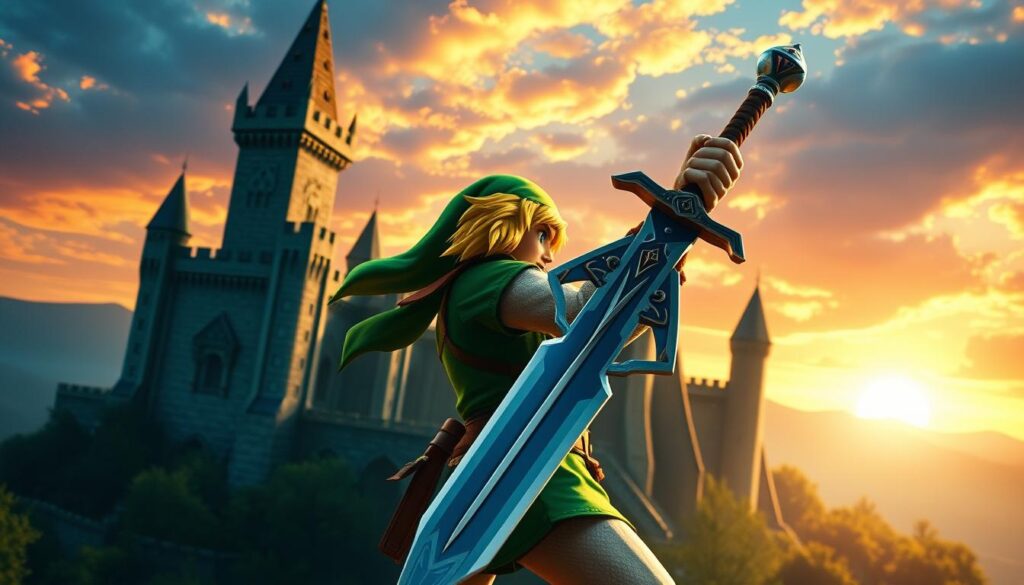
The Legend of Zelda: Ocarina of Time stands as a testament to the innovative spirit of Nintendo, redefining the boundaries of what was possible in 3D gaming. Released in 1998 for the Nintendo 64, Ocarina of Time is widely regarded as one of the greatest games of all time, praised for its engaging storyline, innovative time travel mechanics, and memorable music.
Time Travel Mechanics and Puzzle Design
Ocarina of Time’s time travel mechanics added a new layer of depth to the Zelda series, allowing for complex puzzle design and storytelling. By traveling through time, players could experience the world of Hyrule in different eras, solving puzzles that required careful consideration of the timeline.
Time travel enabled the creation of intricate puzzles that were both challenging and rewarding to solve. This mechanic not only enhanced the gameplay but also enriched the narrative, as players witnessed the consequences of their actions across different timelines.
Musical Innovation and Storytelling
The game’s music was innovative and has been widely praised for its beauty and memorability. The soundtrack, composed by Koji Kondo and Hajime Wakai, perfectly complemented the game’s atmosphere, with iconic themes that have become synonymous with the Zelda series.
The story of Ocarina of Time is considered one of the best in the series, with well-developed characters and an engaging narrative. The game’s impact on the action-adventure genre has been significant, influencing many other titles and cementing its place as a classic.
The Legend of Zelda: Ocarina of Time continues to be celebrated for its contributions to gaming, and its influence can still be seen in modern adventure games.
Final Fantasy VII (1997): The RPG That Conquered the West

In 1997, Square (now Square Enix) released Final Fantasy VII, a game that would change the face of RPGs forever. This iconic title was a critical and commercial success, praised for its deep characters, engaging story, and innovative combat system.
Cinematic Storytelling and Memorable Characters
Final Fantasy VII‘s cinematic storytelling and memorable characters helped to captivate a wide audience. The game’s narrative, filled with complex characters and unexpected plot twists, set a new standard for storytelling in RPGs. The character development, particularly with characters like Cloud Strife and Sephiroth, added depth to the story, making it relatable and engaging for players.
Combat System and Materia Mechanics
The game‘s combat system and Materia mechanics were innovative, offering a deep and engaging gameplay experience. The Materia system allowed players to customize their characters’ abilities, adding a strategic layer to the combat. This innovative system, combined with the game’s cinematic cutscenes and 3D graphics, made Final Fantasy VII a standout title in the RPG genre.
The success of Final Fantasy VII contributed to the global popularity of RPGs, paving the way for other titles in the genre. The game’s legacy continues to be felt, with many considering it a classic of the genre. Its influence can be seen in many subsequent RPGs, and it remains a beloved game among retro gaming enthusiasts.
Resident Evil (1996): Defining Survival Horror

The original Resident Evil game, released in 1996 for the PlayStation, revolutionized the horror gaming landscape.
Resident Evil is credited with defining the survival horror genre, known for its tense atmosphere, resource management, and terrifying enemies. The game’s ability to evoke fear and tension has made it a classic, continuing to be celebrated by gamers.
Atmospheric Terror and Resource Management
The game’s atmospheric tension and resource management mechanics created a sense of fear and vulnerability. Players had to navigate through creepy environments, manage limited resources, and avoid or confront terrifying enemies.
Key Features:
- Limited ammunition and health packs
- Pre-rendered backgrounds that added to the atmosphere
- Tank controls that made movement feel stiff and deliberate
These features contributed to the game’s tense atmosphere and required players to think strategically about their actions.
Legacy and Influence on Horror Gaming
The influence of Resident Evil on the survival horror genre has been profound, with many other titles drawing inspiration from it. The game’s legacy extends beyond its own series, with its impact visible in many other horror games.
Resident Evil’s innovative gameplay mechanics and atmospheric tension have set a new standard for horror games. The game’s impact can be seen in many modern horror games that continue to borrow elements from it.
Pokémon Red and Blue (1996): Gotta Catch ‘Em All

Pokémon Red and Blue, released in 1996 for the Gameboy, revolutionized the concept of collecting and trading within games. This innovative approach not only captivated players worldwide but also laid the foundation for what would become a global phenomenon.
The success of Pokémon Red and Blue can be attributed to their engaging gameplay and the unique concept of collecting and trading Pokémon. This concept sparked a global phenomenon, encouraging players to catch and trade Pokémon, fostering a sense of community among gamers.
Collecting and Trading Phenomenon
The concept of collecting and trading Pokémon captured the imaginations of players worldwide. It was not just about battling; it was about completing the Pokédex, trading with friends, and becoming a true Pokémon Master.
- The concept of collecting and trading Pokémon captured the imaginations of players worldwide.
- Pokémon Red and Blue were instrumental in the success of the Pokémon franchise, laying the groundwork for its future growth.
- The franchise has expanded beyond gaming to include anime, manga, trading cards, and more.
- The enduring popularity of Pokémon is a testament to the engaging gameplay and memorable characters introduced in Red and Blue.
The Birth of a Multi-Media Empire
Over the years, the Pokémon franchise has grown into a multi-media empire, encompassing various forms of entertainment such as anime, manga, and trading card games. The impact of Pokémon Red and Blue on the gaming industry and popular culture is undeniable, making them one of the most significant game releases of the 90s.
The legacy of Pokémon Red and Blue continues to be celebrated by both old and new generations of gamers, a true testament to the timeless appeal of the Pokémon universe.
DOOM (1993): The Grandfather of First-Person Shooters

In 1993, id Software changed the gaming landscape forever with the release of DOOM, a title that would become synonymous with the first-person shooter genre. This groundbreaking game not only captivated players with its fast-paced action but also set a new standard for the industry.
Fast-Paced Action and Weapon Arsenal
DOOM’s success can be attributed to its intense gameplay and diverse arsenal of weapons. Players were immersed in a world of demons and destruction, armed with a variety of firearms and supernatural powers. The fast-paced action kept players on the edge of their seats, making it a thrilling experience.
The game’s weapon variety, from the trusty shotgun to the powerful BFG, added depth to the gameplay. Each weapon had its unique characteristics, encouraging players to strategize and adapt to different combat situations.
Modding Community and Multiplayer Innovation
Another significant aspect of DOOM was its thriving modding community. The game’s modding community created a wide range of custom content, from new levels to entirely different game modes, extending the game’s replayability and lifespan.
DOOM also pioneered multiplayer gaming with its deathmatch mode, a concept that became a staple of the FPS genre. Players could compete against each other, adding a new layer of excitement and competition to the game.
The impact of DOOM can still be felt years after its release, with its influence visible in many modern FPS titles. It remains a beloved classic among gamers and a landmark in the history of video games.
Street Fighter II (1991): The Fighting Game Revolution
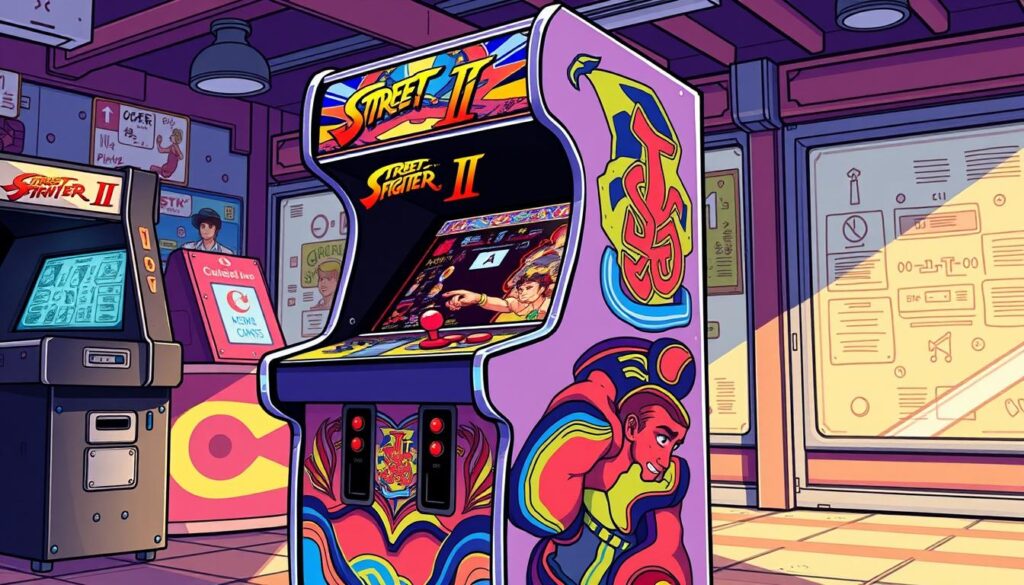
Street Fighter II is often credited with popularizing the fighting game genre. Released in 1991, it not only captivated gamers with its engaging gameplay but also set a new standard for competitive gaming.
Character Roster and Special Moves
One of the key factors behind Street Fighter II’s success was its diverse and memorable character roster. Each character came with unique special moves that added depth to the gameplay. The combination of simple yet complex mechanics made the game appealing to both casual and hardcore gamers.
Iconic characters like Ryu, Ken, and Chun-Li became household names, with their special moves such as the Hadouken and Hyakuretsu Kyaku becoming ingrained in pop culture.
Competitive Scene and Tournament Legacy
The competitive scene surrounding Street Fighter II was vibrant, with numerous tournaments being held worldwide. This not only fostered a sense of community among players but also elevated the game’s status as a competitive sport.
The legacy of Street Fighter II continues to influence the fighting game community, with many considering it a pioneering title that paved the way for subsequent fighting games.
Sonic the Hedgehog (1991): Sega’s Blue Blur

Sega’s flagship title, Sonic the Hedgehog, burst onto the scene in 1991, redefining the platformer genre with its emphasis on speed. As a key player in the console wars, Sonic the Hedgehog was more than just a game; it was a symbol of Sega’s challenge to Nintendo’s dominance.
Speed-Based Gameplay and Level Design
Sonic the Hedgehog’s speed-based gameplay was innovative, offering a different type of platformer experience. The game‘s level design was praised for its creativity and challenge, with colorful and intricate environments that captivated players.
The game’s innovative design allowed for a unique blend of exploration and high-speed action, setting it apart from other platformers of the time.
The Console Wars: Sonic vs. Mario
The rivalry between Sonic the Hedgehog and Mario was a central aspect of the console wars, driving innovation in platformer games. As Sega’s mascot, Sonic hedgehog became an iconic character, symbolizing the company’s challenge to Nintendo.
This rivalry not only fueled the development of new games but also elevated the gaming industry as a whole, pushing the boundaries of what was possible in game design.
Chrono Trigger (1995): The Timeless JRPG Masterpiece
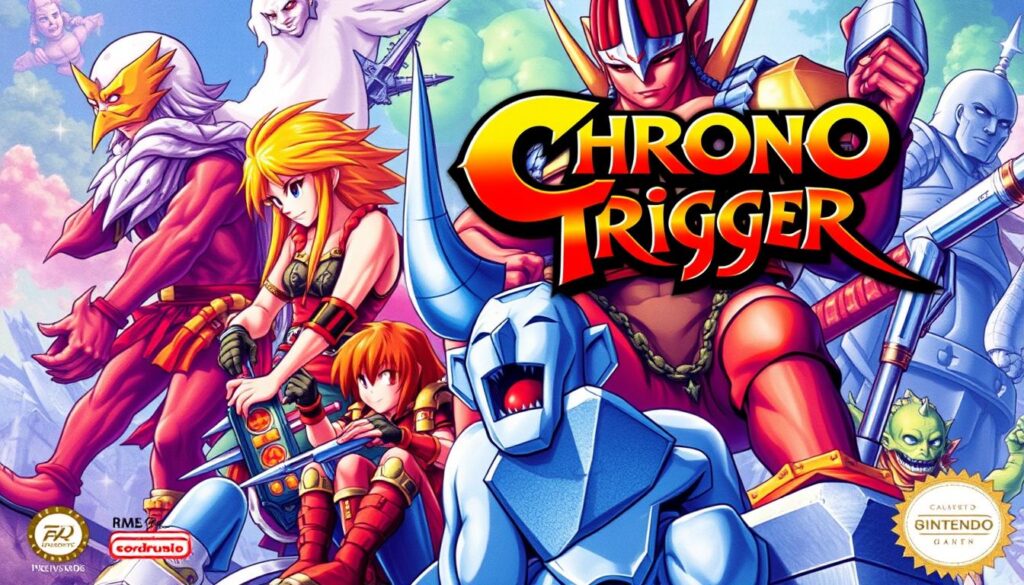
Chrono Trigger, a game that has stood the test of time since its 1995 release, remains celebrated for its story, characters, and innovative gameplay mechanics. This JRPG masterpiece was developed by a “dream team” of renowned creators, which significantly contributed to its quality and enduring appeal.
Time Travel Narrative and Multiple Endings
One of the standout features of Chrono Trigger is its complex and engaging narrative, which involves time travel and results in multiple endings based on player choices. This narrative depth adds a layer of replayability, as players are encouraged to explore different story paths.
The game’s story is not only engaging but also emotionally resonant, with well-developed characters that players can empathize with. The multiple endings further enhance the game’s replay value, making it a title that gamers return to time and again.
Dream Team Development and Artistic Direction
The development of Chrono Trigger was overseen by a team of highly respected creators, including Yuji Horii, Akira Toriyama, and Yasunori Mitsuda, among others. This “dream team” brought together diverse talents, resulting in a game that excelled in various aspects, from its story and characters to its music and overall artistic direction.
The collaboration of these industry luminaries not only elevated the game’s quality but also contributed to its innovative battle system, which allowed for a high degree of strategy and depth. The artistic direction, characterized by Akira Toriyama’s distinctive character designs, further added to the game’s visual appeal.
As a landmark RPG, Chrono Trigger continues to be celebrated for its engaging story, innovative gameplay, and the legacy it has left on the gaming industry. Its influence can still be seen in many modern JRPGs, and it remains a beloved classic among gamers.
Quake (1996): Revolutionizing 3D Gaming
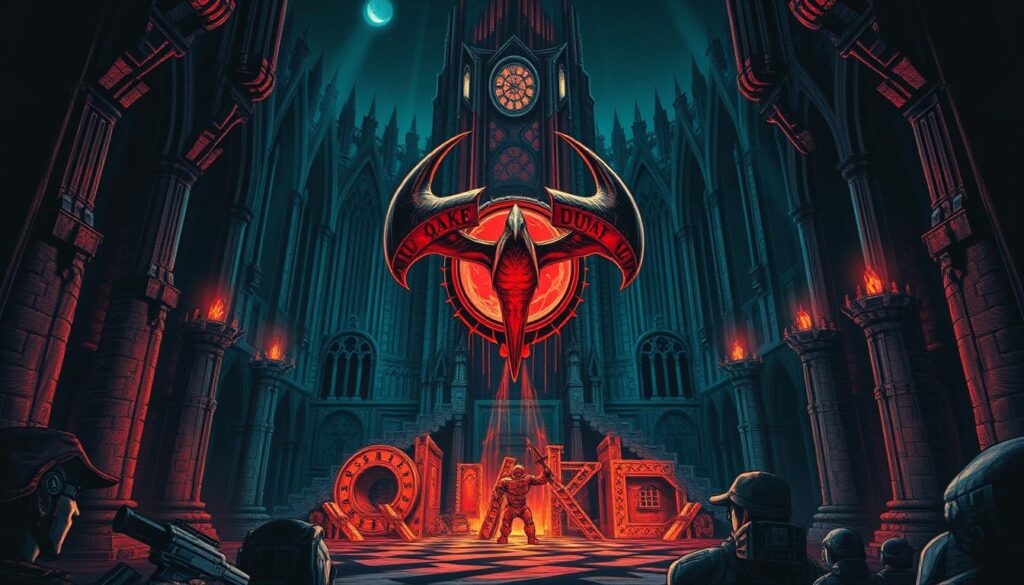
In 1996, id Software unleashed Quake, a game that not only pushed the boundaries of 3D gaming but also redefined it. This seminal title was a significant milestone in the evolution of 3D gaming, known for its true 3D engine and innovative multiplayer capabilities.
True 3D Engine and Technical Innovation
Quake’s 3D engine was a major technical achievement, enabling fully 3D gameplay. This innovation allowed for a more immersive gaming experience, setting a new standard for future games. The engine’s capabilities were showcased through the game’s detailed environments and complex level design.
The technical innovations in Quake did not go unnoticed, as the game became a benchmark for 3D graphics in gaming. Its influence can be seen in many subsequent FPS titles that adopted similar technologies.
Online Multiplayer and Esports Influence
The multiplayer mode in Quake was highly influential, contributing significantly to the development of esports. It introduced competitive online play, which became a staple of the FPS genre. Players could engage in deathmatches, fostering a competitive community around the game.
Quake’s impact on the FPS genre was substantial, with its gameplay mechanics and technical innovations being adopted by other titles. The game’s legacy continues to be felt, with its influence on 3D gaming and multiplayer FPS games still evident today.
Honorable Mentions: Other 90s Classics
The 90s gaming landscape was rich with iconic titles, and while some made it to our top 10, others are equally worthy of mention. These games, though not necessarily in the spotlight, contributed significantly to the diversity and richness of the gaming world.
Iconic Strategy Games
Games like Age of Empires and StarCraft revolutionized the strategy genre. Age of Empires brought historical depth and engaging gameplay to the table, while StarCraft became a cornerstone of competitive gaming with its fast-paced action and multiplayer capabilities.
| Game Title | Release Year | Genre | Notable Feature |
|---|---|---|---|
| Age of Empires | 1997 | Real-time Strategy | Historical Campaigns |
| StarCraft | 1998 | Real-time Strategy | Multiplayer Competitive Scene |
Adventure Game Gems
The adventure genre was also blessed with gems like The Secret of Monkey Island and Grim Fandango. The Secret of Monkey Island is celebrated for its humor and challenging puzzles, while Grim Fandango is praised for its engaging story and memorable characters.
- The Secret of Monkey Island is known for its witty dialogue and pirate-themed adventure.
- Grim Fandango combines noir elements with a unique blend of puzzle-solving and exploration.
These games, among others, have left a lasting impact on the gaming community. They represent some of the best of the decade and continue to be celebrated and enjoyed by gamers today.
Conclusion: The Lasting Impact of 90s Gaming
The legacy of 90s gaming continues to be felt today, with many of its innovations remaining relevant. The 1990s was a transformative period for the gaming industry, marked by significant technological advancements and innovative game design.
The impact of 90s games can be seen in many modern titles, which have built upon the foundations laid during that decade. The influence of 90s gaming extends beyond the industry, with many of its iconic characters and franchises becoming part of popular culture.
In conclusion, the continued celebration and enjoyment of 90s games are a testament to their enduring appeal and the significant role they played in shaping the gaming landscape. The way game development has evolved is a direct result of the pioneering work done in the 90s.
FAQ
What made Super Mario World so iconic?
Super Mario World is considered one of the best platformers of all time due to its tight controls, charming graphics, and innovative power-ups like the Cape Feather.
How did Final Fantasy VII impact the RPG genre?
Final Fantasy VII brought cinematic storytelling and deep characters to the RPG genre, making it more accessible to Western audiences and influencing many subsequent RPGs.
What is the significance of Resident Evil in the survival horror genre?
Resident Evil defined the survival horror genre with its tank controls, resource management, and atmospheric tension, paving the way for future horror games.
Why is Street Fighter II considered a classic?
Street Fighter II revolutionized the fighting game genre with its diverse character roster, special moves, and competitive gameplay, becoming a staple of arcade culture.
How did Sonic the Hedgehog impact the console wars?
Sonic the Hedgehog was a mascot for Sega and a direct competitor to Nintendo’s Mario, offering fast-paced gameplay and challenging level design that appealed to a different audience.
What makes Monkey Island a beloved adventure game?
Monkey Island is cherished for its humor, engaging characters, and challenging puzzles, setting a high standard for adventure games and developing a loyal fan base.
How did the transition from 2D to 3D gaming affect the industry?
The shift from 2D to 3D brought significant technical challenges and opportunities, leading to innovations in game design, camera systems, and player interaction.
What legacy did the games of the 90s leave on modern gaming?
The games of the 90s laid the groundwork for many modern genres and gameplay mechanics, continuing to influence game development today.
